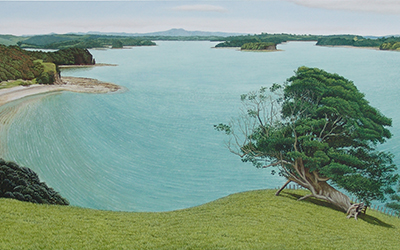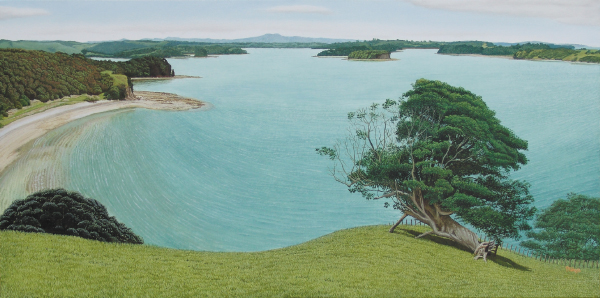Submission on the proposed Auckland Unitary Plan


Harbourscape Protection Mission: Mahurangi Action’s most sacred mission is to protect a harbourscape of outstanding natural beauty. When the landscape is beautifully protected, much of the hard work, of sediment attenuation for example, will also be addressed. artist Philip Kilmore
Formed in 1974 as Friends of the Mahurangi, Mahurangi Action Incorporated is a community interest group that, from its inception, has been primarily concerned with protection, enhancement and enjoyment of the outstanding natural landscape that is the Mahurangi Harbour.
As the nearest natural harbour north of the city on Auckland’s popular east coast, the Mahurangi is remarkably unbuilt. The seaward approaches and heads of the harbour are unquestionably regionally significant landscape, much of which was protected from urban development through acquisition as regional parkland in the late 1960s and early 1970s. The harbour and its environs have a landscape value on par with a significant lake or mountain.
The Mahurangi Harbour faces two major threats: Loss of landscape value and an elevated sediment accumulation rate. Mahurangi Action’s submission concentrates on the need for landscape protection, but not because action to reduce sedimentation is less important—most of the society’s energy is devoted to a strategy of adding value to the council-led efforts to reduce the sediment accumulation rate. The landscape focus here is because if there is a loss of landscape value due to incompatible residential and other development, that loss [would] be permanent, whereas the sedimentation rate is being actively tackled, even if there are at least decades more work to be done before the catchment is adequately protected from the projected increase of extreme weather events due to anthropogenic global warming. Already, in recent decades, parts of the harbour’s incomparable scenic ridge roads now have a residential look and feel disproportionate to the small actual amount of residential development.
Mahurangi Action is the principal instigator of the proposed Mahurangi Coastal Trail that would link the Wenderholm, Te Muri and Mahurangi regional parks together, to public transport at Waiwera, and to Te Araroa, the national walkway. This proposal epitomises the overarching proposed Unitary Plan goal of encouraging urban intensification while extending recreational opportunities for those seeking to reduce reliance on private transport.
Mahurangi Action reiterates its submission to the draft Auckland Unitary Plan, but adds one further point—at point 6:
- Mahurangi Action supports the protection afforded to prime areas of the Mahurangi Harbour by the Outstanding Natural Landscapes overlay.
- Mahurangi Action is concerned, however, that the Outstanding Natural Landscapes overlay applies to areas distant from the harbourscape, and elsewhere, such that overuse of the overlay providing highest protection would have the effect of diluting protection for the most sensitive landscapes.
- Mahurangi Action disagrees with the very small area of the harbour which the Outstanding Coastal Natural Character Area overlay applies to and urges that it be applied to the seaward approaches and heads of the harbour, in place of the ‘High’ overlay, which is used for the often extensively modified coastal landscapes between Mahurangi and the Waitemata Harbour.
- Mahurangi Action supports zoning of the bulk of the harbourscape as Rural Coastal.
- Mahurangi Action supports application of the Significant Ecological Area overlay to harbour, and the excluding of mooring areas from that overlay.
- Mahurangi Action asks that amendments be made to any provisions in the Proposed Unitary Plan that might create an unexpected hindrance to the proposed Mahurangi Coastal Trail, particularly the proposed Puhoi River footbridge, with opening span to preserve river navigation.
In addition to these six points, Mahurangi Action endorses the submissions by the Environmental Defence Society and by Friends of Regional Parks, in their entirety.
In respect to the Environmental Defence Society’s summary of key issues on proposed Auckland Unitary Plan circulated 17 February, Mahurangi Action particularly makes reference to, and endorses:
- Sedimentation affecting the CMA is not adequately controlled, especially that from non-point discharges in the rural area, and there is no linkage between the management of sediment-generating activities and the areas of degraded water quality (which include most of the major estuaries in the region) which are identified in the RPS.
- The management of aquaculture is very inadequate and the controls proposed insufficient to ensure that important values within the coastal environment are protected whilst enabling aquaculture to occur.
- Mangrove removal has been provided for but has not been strongly linked to the management of sediment-generating activities, which is necessary to ensure that the adverse effects of mangrove removal can be avoided in the future.
- The management of development in areas affected by natural hazards including sea-level rise is inadequate, and fails to address the seriousness of the problem and need to avoid new development in hazard areas.
In respect to the Friends of Regional Parks submission, Mahurangi Action particularly makes reference to, and endorses:
- FORParks notes that Te Muri Regional Park including the section previously forming part of Mahurangi Regional Park has not been shown on the Maps as included in the Regional Park Precinct.FORParks submits that in accordance with the Unitary Plan Part 7 Designations 401 and 426, these regional park areas should be shown on the maps as included in the Regional Park Precinct to ensure consistent, effective and appropriate management of these areas of outstanding natural character.
- Encourage the development of open spaces and multiuse trails connecting conservation areas to other open spaces using non-motorized transportation.
In respect to the Aquaculture New Zealand submission, Mahurangi Action supports oyster farming remaining a discretionary activity, so as to allow the Unitary Plan to have the flexibility to respond to improved marine farming methods. Oyster farming in the Mahurangi Harbour is a valued part of the visual, social and economic landscape.
Footnote In the haste of preparing and lodging this submission, the final paragraph was confused. It should have stated:
New aquaculture areas should be discretionary to allow new novel types of aquaculture to be considered, and existing aquaculture areas conditional to create certainty, to encourage investment in, and good management of, the existing aquaculture areas.
This point will be stressed by Mahurangi Action when submitters to the proposed Auckland Unitary Plan are heard.
